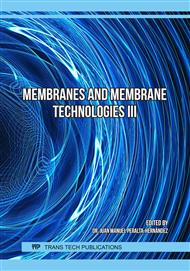p.45
p.49
p.55
p.59
p.67
p.76
p.82
p.88
p.94
Analysis of the Influence of Pore-Forming Agent and Coagulation Bath on the Preparation of PES Hollow Fiber Membrane
Abstract:
PES is used as raw material for the preparation of membrane in this paper. Through gas-assisted-phase separation and synergetic pore-forming technology, the influence of the content of CaCO3 in foaming pore-forming agent and the content of N,N-DMAc in coagulation bath on membrane property is studied. The results indicate that this method prepares PES hollow fiber membrane with uniform macroporous structure in which the cross section is wedge-shaped and running through internal and external surface. The addition of CaCO3 can improve membrane property and the increase in the content of DMAc also has a great positive influence on membrane property.
Info:
Periodical:
Pages:
67-75
Citation:
Online since:
January 2020
Authors:
Price:
Сopyright:
© 2020 Trans Tech Publications Ltd. All Rights Reserved
Share:
Citation:



